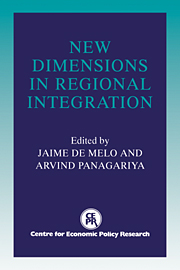Book contents
- Frontmatter
- Contents
- List of figures
- List of tables
- Preface
- Foreword
- Acknowledgements
- List of conference participants
- PART ONE SYSTEMIC ISSUES
- 1 Introduction
- 2 Regionalism and multilateralism: an overview
- Discussion
- 3 Regionalism versus multilateralism: analytical notes
- Discussion
- 4 Multilateral and bilateral trade policies in the world trading system: an historical perspective
- Discussion
- 5 GATT's influence on regional arrangements
- Discussion
- PART TWO COUNTRY ISSUES
- Index
1 - Introduction
Published online by Cambridge University Press: 04 May 2010
- Frontmatter
- Contents
- List of figures
- List of tables
- Preface
- Foreword
- Acknowledgements
- List of conference participants
- PART ONE SYSTEMIC ISSUES
- 1 Introduction
- 2 Regionalism and multilateralism: an overview
- Discussion
- 3 Regionalism versus multilateralism: analytical notes
- Discussion
- 4 Multilateral and bilateral trade policies in the world trading system: an historical perspective
- Discussion
- 5 GATT's influence on regional arrangements
- Discussion
- PART TWO COUNTRY ISSUES
- Index
Summary
The cornerstone of the post-World War II world trading system is the most favoured nation (MFN) clause that underlies all GATT-negotiated reductions in tariffs. Through the MFN clause, non-discrimination creates global order out of an essentially mercantilist system. Most importantly perhaps from the standpoint of lesser nations with little bargaining power, through the application of the MFN clause, purely bilateral bargains negotiated under the auspices of the GATT become available to all. Enormous progress towards global free trade has been made under this non-discriminatory approach to tariff reductions. For example, between the opening of the first round of multilateral talks in Geneva in 1947 and the close of the Tokyo round in 1979, the average US tariff had declined by nearly 92 percent. On the eve of the Uruguay round in 1987, the average tariff for the United States was 4.9 percent, for the European Community it was 6.0 percent, and for Japan it was 5.4 percent.
This long period of progressive trade liberalisation also witnessed two waves – waves because they came suddenly, and the first one at least, foundered – of regional trading arrangements. The first came during the early 1960s. Under the impetus of the European Common Market, regionalism spread throughout Africa, Latin America and other parts of the developing world. The United States was then a hegemon and a staunch supporter of multilateralism. Regionalism then came to a halt during much of the 1970s.
The second wave started in the middle 1980s. This time around, the United States was a major player.
- Type
- Chapter
- Information
- New Dimensions in Regional Integration , pp. 3 - 21Publisher: Cambridge University PressPrint publication year: 1993
- 9
- Cited by

